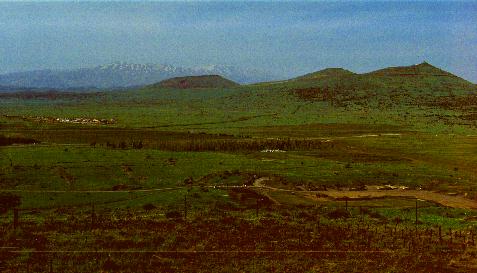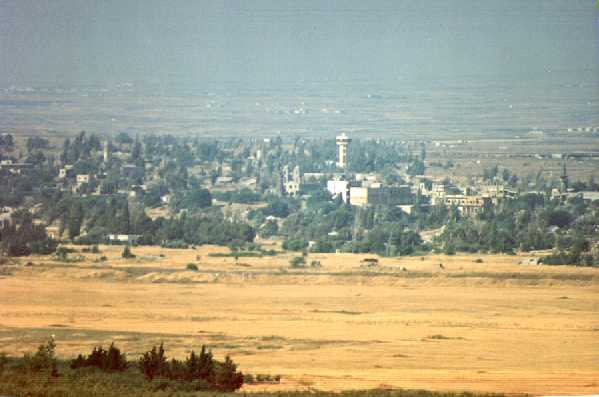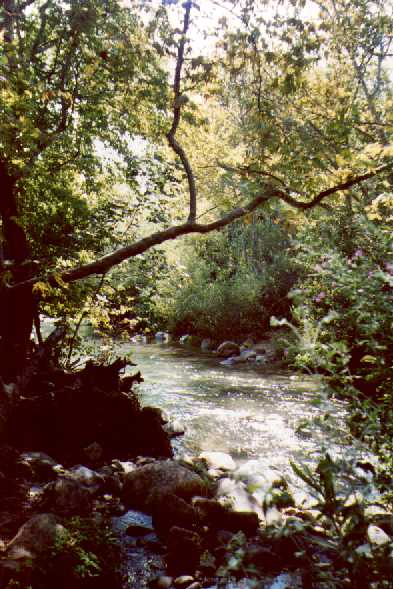 Golan Heights, Israel
Golan Heights, Israel Golan Heights, Israel
Golan Heights, Israel
The Golan Heights sit in the northeast corner of Israel. They were captured along with the West Bank, Gaza and Jerusalem during the 1967 Six Day War. Prior to its capture the Golan had been part of Syria, and the Syrians still seek its return. The Israeli Knesset voted on December 14, 1981, to annex the Golan as an integral part of Israel, as opposed to most of the other territories which remain under military rule. This claim is not recognized by most other countries.
 The
Golan is surprisingly small for all the press it receives. It is a mere
1,190 square km (459 square miles). The two panoramic pictures shown are
shot from the same the same hilltop. The tall hills in the image
at the top of the page are just inside the Syrian border on the eastern
edge. The lake along the horizon to the right in the other picture
is the Kineret (or Sea of Galilee) which sits inside Israel proper its
west side. (And this exaggerates things since the second shotis made looking
southwest, not due west.) In fact, the average width of the Heights
from the Syrian border to the 1948 Israeli "Green Line" borders is a mere
20 km. It represents less than 1% of the total land area of Syria.
The
Golan is surprisingly small for all the press it receives. It is a mere
1,190 square km (459 square miles). The two panoramic pictures shown are
shot from the same the same hilltop. The tall hills in the image
at the top of the page are just inside the Syrian border on the eastern
edge. The lake along the horizon to the right in the other picture
is the Kineret (or Sea of Galilee) which sits inside Israel proper its
west side. (And this exaggerates things since the second shotis made looking
southwest, not due west.) In fact, the average width of the Heights
from the Syrian border to the 1948 Israeli "Green Line" borders is a mere
20 km. It represents less than 1% of the total land area of Syria.
The importance of the Golan is threefold.
 The
eastern edge of the heights are the highest point between Israel and Syria's
capital city of Damascus. Israel enjoys a direct surveilance position of
the capital and a superior position to repulse a Syrian attack.
The
eastern edge of the heights are the highest point between Israel and Syria's
capital city of Damascus. Israel enjoys a direct surveilance position of
the capital and a superior position to repulse a Syrian attack. Compared
with Israel's other disputed territories, the Golan is relatively empty.
Approximately 20,000 Syrian Druze remain in the Golan waiting for reunification
with their homeland. An approximately equal number of Israelis (mostly
former soldiers stationed here) have moved into this relatively isolated
part of the country. Since the Golan lay outside of British Palestine,
the Golan is a matter between Israel and Syria only and is not part of
the Israel-Palestinian dispute. Most of the Golan is taken up with farming
communities, and military practice ranges.
Compared
with Israel's other disputed territories, the Golan is relatively empty.
Approximately 20,000 Syrian Druze remain in the Golan waiting for reunification
with their homeland. An approximately equal number of Israelis (mostly
former soldiers stationed here) have moved into this relatively isolated
part of the country. Since the Golan lay outside of British Palestine,
the Golan is a matter between Israel and Syria only and is not part of
the Israel-Palestinian dispute. Most of the Golan is taken up with farming
communities, and military practice ranges.
In addition to it's use as a defensive barrier, the Golan is one of Israel's outdoor playgrounds. It is one of the most beautiful regions for outdoor hiking, and on the slopes of Mt. Hermon, Israel's highest Mountain, is Israel's one and only ski area.
| Grand Central Station | |
|---|---|
|
|
|